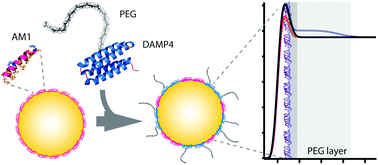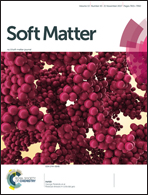Insights into the interfacial structure–function of poly(ethylene glycol)-decorated peptide-stabilised nanoscale emulsions†
Abstract
The interfacial properties of nanoscale materials have profound influence on biodistribution and stability as well as the effectiveness of sophisticated surface-encoded properties such as active targeting to cell surface receptors. Tailorable nanocarrier emulsions (TNEs) are a novel class of oil-in-water emulsions stabilised by molecularly-engineered biosurfactants that permit single-pot stepwise surface modification with related polypeptides that may be chemically conjugated or genetically fused to biofunctional moieties. We have probed the structure and function of poly(ethylene glycol) (PEG) used to decorate TNEs in this way. The molecular weight of PEG decorating TNEs has considerable impact on the ζ-potential of the emulsion particles, related to differential interfacial thickness of the PEG layer as determined by X-ray reflectometry. By co-modifying TNEs with an antibody fragment, we show that the molecular weight and density of PEG governs the competing parameters of accessibility of the targeting moiety and of shielding the interface from non-specific interactions with the environment. The fundamental understanding of the molecular details of the PEG layer that we present provides valuable insights into the structure–function relationship for soft nanomaterial interfaces. This work therefore paves the way for further rational design of TNEs and other nanocarriers that must interact with their environment in controlled and predictable ways.



 Please wait while we load your content...
Please wait while we load your content...